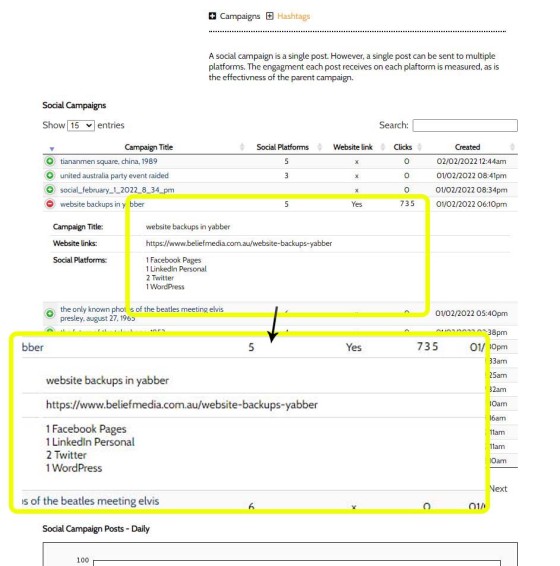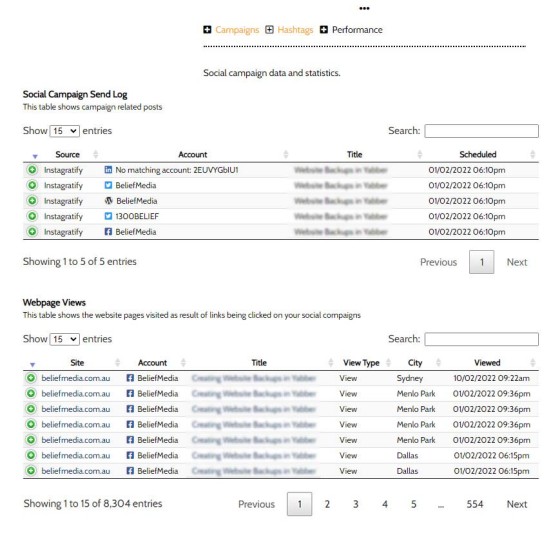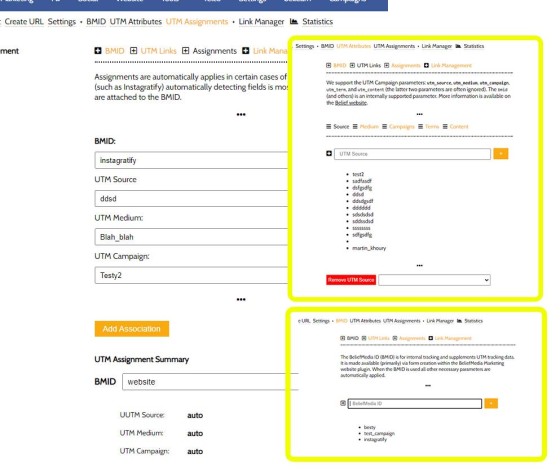If your business actively engages with digital marketing of any kind you should be using UTM tracking codes in all the URLs associated with all your online campaigns. This article details what UTM tracking codes are, how they're used, and how they integrate with our Yabber marketing Platform. The UTM tags as discussed in the article are intrinsically connected to the website we provide clients and our comprehensive social media modules.
A significant advantage of digital marketing is that we can assess any online (and most offline) interactions, meaning that our marketing spend can be managed to return an optimised return on investment. In terms of measuring website interactions, the UTM URL parameters are not the only means of making this assessment, but they're used by Google and others (including us) as default tags for assessing how any why a user landed on any specific page on your website. If you're not using the tags for every URL you share, or your managed social media representation doesn't include the tags in every post they share on your behalf, your understanding of your digital traffic is seriously compromised and you're costing yourself valuable marketing insights.
UTM is an acronym for Urchin Traffic Monitor, with Urchin Corporation  being the developers of the initial software that would analyse server log information and traffic data. Sales of Urchin products ended on March 28, 2012 and the product was acquired by Google in April 2005 forming the basis of Google Analytics. Google continued to sell Urchin as a standalone product until 2012, but with the powerful and free Analytics suite the paid product never gained traction. This shift meant that marketers needing data reprocessing data, search engine crawler activity, failed requests to server, and unique IP tracking would have to source another product... and any serious marketing agency needs these features.
being the developers of the initial software that would analyse server log information and traffic data. Sales of Urchin products ended on March 28, 2012 and the product was acquired by Google in April 2005 forming the basis of Google Analytics. Google continued to sell Urchin as a standalone product until 2012, but with the powerful and free Analytics suite the paid product never gained traction. This shift meant that marketers needing data reprocessing data, search engine crawler activity, failed requests to server, and unique IP tracking would have to source another product... and any serious marketing agency needs these features.
In most cases Google Analytics provides as much insight as most businesses need. However, our clients aren't 'most businesses', and Google's platform does not provide an understanding of identified or resolved consumer behaviour, so we built our own statistical engine that enables extremely powerful funnels that include conditional website pathways based on the known interest type for any single user. The UTM data passed to our site from inbound links help our AI engine resolve the user interest type and tailor their customer journey into one that is more likely to convert.
A typical URL with UTM parameters included might look as follows:
https://www.beliefmedia.com.au/utm-tracking?
utm_campaign=blog&utm_medium=social&utm_source=facebookIn the above example we've used just three of the standard UTM tags, utm_campaign, utm_medium, and utm_source - it's the values associated with each of these URL parameters that is recorded with your statistics. As discussed shortly, applying these URL parameters is a time consuming and clumsy operation that is prone to errors so we've completely automated the process for any link that passes through Yabber - this enables highly accurate and consistent statistics to be recorded and returned to a user. In the case of social media you'll know exactly how any share performed on each social media platform your message was sent.
The five standard UTM tags are shown below but it should be known that we've added a number of other URL parameters in order to gain a deeper understanding of each interaction. In fact, for any website page view we record very user-specific statistics (for example, this enables to you identify what lead clicked on a Facebook or other social link if that user was previously known).
Standard UTM parameters are shown below. Note that while we provide examples of usage, there's no hard rule for how UTM parameters should be used, except that the tags should generally be hierarchical in design.
utm_source
utm_source is used to identify a search engine, newsletter name, or other source. In our case, and when automatically applied, Yabber will generally add a utm_source of 'yabber', 'vista', 'instagratify', 'bm_managed', or something else to identify the system used to generate a message.
utm_medium
Use utm_medium to identify a medium such as email, social, blog post, QR Code, or cost-per-click reference.
utm_campaign
Used for keyword analysis. Use utm_campaign to identify a specific product promotion or strategic campaign.
utm_term
The utm_term is often Used for paid search to note the keywords for this ad.
utm_content
This field is often used for A/B (split) testing and content-targeted ads. You might use utm_content to differentiate ads or links that point to the same URL. Many will use a phrase that differentiate similar content on the same page, such as unique call to actions or buttons.
Manually Creating UTM Tags
If you are manually creating your UTM parameters there's a number of very general rules to follows.
- Consistency. Use standard, short, and descriptive terms. Depending upon the system you use to measure traffic the tags are often case-sensitive, so ensure that you keep to lower-case text.
- Spaces and Bad Characters. The URL parameters in your URL are part of the URL, so any character that might form part of a URL should be avoided. This includes spaces, the pound symbol (#), ampersands (&), and equal signs. Following on from the consistency point, you might include nothing other than lowercase numbers, letters, and underscores.
- Internal Linking. You should generally avoid internal linking (such as linking to a page via a standard menu item or logo). This updates the tracking session so the original source of your visitor is often lost.
- Don't forget
utm_source. Tracking is often ignored in some systems if theutm_sourceparameter is missing (this applies in Google Analytics - not in Yabber). - Consider analytics behaviour. UTM tracking is not specific to Google Analytics by any means, but they do tend to set trends. If you're using GA, be mindful of their preferred naming convention; for example, setting the
utm_mediumto 'cpc' will usually return that traffic under the paid search tab, meaning that it won't be assessed as social or other traffic. - SEO Canonical URL. With various link floating around the web that all carry varying parameters, it's important to ensure you render a canonical URL into your page source so search engines know where they should attribute the link juice.
The only time Yabber subscribers will have to manually create a URL is when providing a link for somebody else to use (such as a link on another website, or perhaps an affiliate link) so you're able to measure the nature of traffic originating from websites outside of your control. Keep in mind that many suggest the 'referral' source is a better means of assessing external links but UTM tracking is arguably more reliable.
You can read more about buiding UTM tracking URLs on Google's website  .
.
BM UTM Tracking
As mentioned earlier, we don't use UTM tags for internal website links. Instead, we pass each request to our servers before a redirection is applied to the destination URL. This is done so that various triggers can be applied, and the redirected URL can carry tags or content necessary to generate conditional content. As a rather advanced system it isn't something our standard website client will use until their marketing matures to a certain level. The turnkey importance, however, is that the data we record is seriously significant and enables a leading understanding of consumer behaviour.
Read more about internal website linking in an article titled "Internal Website Links and Conditional Methodology".
Social Media Campaign Tracking
Introduction
Whenever a social media post is created on any of our integrated social media systems, such as Instagratify, Yabber, or Vista, a social campaign is automatically created. This social campaign consists of all the messages sent to social media, and identifying and platform-specific UTM tags are applied to each post when sent to the destination social platform. This integrated automation means we're able to easily identify and measure the precise engagement originating from any social platform - including any conversions that might come by way of the visit. If you're in the business of managing multiple pages on the same platform (such as franchise or aggregation groups) we're able to easily determine what pages returned better results (this is a good example of the hierarchical nature of tags, since in our case the utm_medium might be facebook_pages, and the utm_campaign applied to each URL will resolve to the actual Facebook page). Over time you can very clearly identify what campaigns deliver better results, the time of day that is more likely to attract engagement, and what type of content is more likely to deliver conversions.
In all cases where a visitor arrives on your website by virtue of a social campaign various other URL parameters are often applied by the referring platform, such as fbclid in the case of Facebook, and gclid on Google. These attributes are obviously also recorded in order to gain a deeper understanding of social traffic.
While it may appear a little complicated, the UTM process is entirely automated. Regardless of what system is used your social UTM tags are automatically applied and a parent campaign provides detailed statistics.
Social Statistics
We've introduced the nature of our integrated social and website statistics in the past. Generally speaking, there's no data that we don't record and then return back to a user in Yabber. A menu in the social panel returns campaign data and specific campaign statistics (showing data that generally isn't rendered in standard website statistics).
Pictured: The campaign panel. Dummy data shown. The campaign panel shows very basic data on each campaign sent (remembering that each campaign is just a single social media post with an associated distribution schedule). The table simply shows the number of social media platforms the post was sent, and the number of total visits as a result of the campaign.
Selecting any campaign returns a page that shows the data and statistics associated with each share.
Pictured: Social performance. Dummy data shown. Clicking on any campaign returns social performance data and statistics. A better representation of the statistics is shown in the next image.
The campaign performance page is better represented by a larger image (with the statistics occupying large screen real-estate, rendered under the campaign panel above).
Pictured: Social performance. Dummy data shown. Statistical data is returned at the general (aggregate) level and campaign level.
Without understanding what the data itself is telling you, you'll very quickly identify those shares that returned most traction, or those that returned most conversions. It is the UTM data automatically applied to social shares that provides us with this deep understanding of our social traffic.
The Former BMID Module and Shor.tt
Existing clients will be familiar with the old and now semi-retired BMID. The BMID was a single value that was associated with multiple UTM tracking values. Other values were automatically applied (as we do now) but, overall, the system introduced complexity to something that didn't really even require user intervention. The system sits in our Shor.tt module and will remain, but it's no longer applied to general campaigns.
Pictured: Dummy data shown. The now mostly-retired BMID UTM module. All manual UTM creation is now replaced by consistent and predicable UTM data. The BMID continues to be used for some managed campaigns to ensure consistency in data.
When a shor.tt URL is created and no UTM data is applied, basic UTM data will will be concatenated to the redirect URL - this includes the shor.tt ID, user IP address, and other very general values. If UTM parameters were applied to the supplied URL then only missing values will be added.
General Campaign Tracking
As stated, UTM tracking is mainly applied in Yabber when sharing social media or other inbound links. However, each Yabber module has its own integrated manner in which to record data. This includes a standalone system for measuring email marketing interactions, downloads, and so on. The single commonality shared between every Yabber system is what's called the BMUID - a single value that connects a specific user to various systems such as the multiple emails that any single user might use, their interactions of any kind (such as downloads, link clicks, page views, or form submissions), and their website navigation. It's this holistic and tight integration that allows very comprehensive data to be recorded, and user-specific website funnels and pathways to be crafted.
A feature we've used for Platinum subscribers is the 'social trigger' that will launch actions based on a known user responding to a specific social campaign, or arriving from a specific social platform, and it's highly likely we'll migrate this feature back into the standard Yabber platform. Another feature that is pending is very similar to webpage campaign messages in that we'll show a message to a user based on the social campaign they're responding, or the specific platform that sent us the traffic.
Conclusion
Our social media integration and the associated campaign management is a default and core inclusion in a Yabber subscription. Unlike other (managed) social services that charge a premium for what is often a ridiculously mediocre product, we return the data necessary to act upon and actually improve your marketing efforts. Marketing without comprehensive data is an exercise in futile guesswork.
We include social media and campaign data as a service simply because it's an essential funnel tool that literally amplifies the effectiveness of any kind of promotion - both paid and organic - and it's UTM data that makes much of this data available.
The UTM data is just one small part in a much bigger machine that ensures our clients always return better results, and more conversions.












